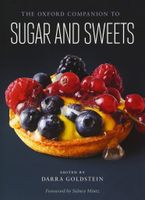Today
Published 2015
Even centuries ago, Middle Eastern pastries and confections tended to avoid the sweet–sour combination, which was considered appropriate only for meat dishes. As a result, the sole fruit regularly used in sweet preparations has been the very sugary date. Mixed dried fruits, however, are cooked together as fruit compote, khoshāf.
Some of the medieval pastries have survived to the present: zulābiyā (also called mushabbak, meaning “lattice”), qaؓā’if; aşābi‘ Zainab (or related names meaning “lady’s fingers,” such as şawābi‘ al-sitt), and luqam al-qādī. Puddings are still popular: muhallabiyya (usually thickened with cornstarch), rizz bi-ḥalīb (rice pudding, which has medieval antecedents), and mughlī (a nut-enriched cross between a pudding and a custard). See pudding. At one point in the late Middle Ages, a crumbly butter cookie evolved under the name ghurayba (literally, “the little extraordinary thing”). Borrowed in Turkish, it was pronounced kurabiye, the name by which it has become known in the West through its Greek spelling, kourambies (pl. kourambiedes).
Become a Premium Member to access this page
Unlimited, ad-free access to hundreds of the world’s best cookbooks
Over 160,000 recipes with thousands more added every month
Recommended by leading chefs and food writers
Powerful search filters to match your tastes
Create collections and add reviews or private notes to any recipe
Swipe to browse each cookbook from cover-to-cover
Manage your subscription via the My Membership page
Part of
Advertisement
Related Recipes
-
-
-
-
Related Reference
-
-
-
-
Advertisement



